Renaissance(1440-16490)
Interior decoration as a professional discipline began during the Renaissance. This period saw great change and revival in art and architecture, and interior design became recognized as a professional art form. The idea of carefully arranging interior furniture so that it becomes a decoration and arranging fabrics in an organic harmony is gaining popularity throughout Europe."Elegant and civilized indoor living"This kind of value and concept thus began to obey a set of established rules, thus forming the art of interior design, and the window decoration industry developed accordingly. WoodMade of shutters were the main tracery of the Renaissance.Installed indoors or outdoors, the shutters block rain and strong sunlight when closed, but do not provide warmth. The blinds at that time were purely functional.
16The introduction of sheer tulle in the century made possible the birth of simple and practical curtains. Most of these tandems are made of fine muslin and chintz, which can control the brightness of the light and protect people's privacy to a certain extent. Curtains are hung from hooks on iron rods and are usually a single drapey drapery. they are17century50It became widely used after the 1980s.
Although the tracery of the Renaissance period is generally simple and plain, the curtains on the periphery of the bed and the partition wall of the room are very particular, so as to protect people's privacy and prevent the wind and noise from passing through the whole house. This type of curtain is called door curtain. A door curtain is usually hung in a room, with a piece of fabric folded together and tied to one side during the day, and unfolded to cover the door at night for privacy. In this day and age, a bed is one's most prized possession. The bedroom of princes and nobles must reflect the respect of the owner. The canopied four-poster bed is very large and has a wooden structure with intricately hand-carved designs. The bed net is fitted under the canopy and surrounds the entire bed. In northern climates, the bed net can be used for warmth and wind protection, while in warm Mediterranean countries, its main function is to prevent insects.
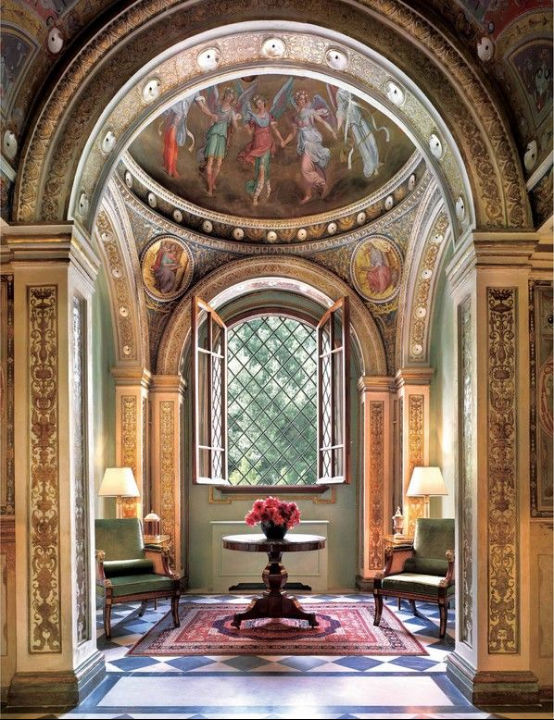

The fabrics at this time were mostly plain woven silk, wool and cotton. Due to the development of new weaving methods,France and Italy began to widely use velvet and woven cotton with rich and bright colors. Cotton fabrics are also available in hand-printed and colorful floral designs.
Towards the end of the Renaissance, curtains began to be incorporated into tracery. Triangular blinds and curtain boxes, inspired by classical Greek motifs, finished the period, before more elaborate tracery flourished in the Baroque period.
Baroque and Early Georgian (1643-1730)
The Baroque period saw a leap forward in tracery. For the first time in history, curtains became an elaborate and unique decorative element in interior design. New advances in weaving techniques, coupled with an increase in the amount of cotton fabric imported from India, created new fabrics dedicated to curtains.
The most common word used to describe tracery in the Baroque period is more"fine"and"exaggerate"up. Cornice boxes and boxes are important and the preferred method of finishing the top surface of window treatments. Their primary function is to cover the curtain rod and the curtain mover fitted underneath. Cornice curtain boxes are made of wood and are usually handcrafted with very intricate patterns. Unlike cornice-style curtain boxes, curtain boxes are usually made of reinforced fabric and often have hand-trimmed edges.
Beads——a decorative border, rose in France during the reign of Louis XIV. Later, in the face of religious persecution, the Huguenots went to Germany, England and the Netherlands, and brought their exquisite craftsmanship with them.
美丽的装饰最初用于掩饰窗幔的接缝,后来演变成王公贵族专享的装饰细节。在巴洛克时代的鼎盛时期,细绢纱制成的平织带、流苏和饰条被用作天鹅绒、织棉和花缎花边。
起初窗帘是简单的单幅织物,后来将它们设计为成对的两幅窗帘,其创新之举是在窗口营造了对称之美。这样一幅窗帘通常在日常用一块布料或者金属帘扣往后系起来,晚间则拉上它以保护隐私。
17世纪的法国艺术家和室内装潢商丹尼尔·莫洛托别认为是花彩装饰设计的创始人。华彩一种织物,可在窗帘上拉起,创造一种帷幕的效果。收到这种理念的启发,许多不同风格的窗帘和短幔应运而生,其中垂花饰和尾饰是最著名的。窗扇在白天提供光照控制,由非常精细的薄织物在油中浸泡过后绷在框架上。框架固定在窗上,浸过油的织物变得半透明,成为阻碍阳光的屏障。
床的顶篷也变得更加细致。实质的木质结构要比文艺复兴时期小,但是窗幔和窗帘的样式更加多样,装饰更加精细。富丽的刺绣提花布和丝绸常常垂挂在木质结构下方的吊杆上。
欧洲巴洛克时期,英国和美国的装饰风格是乔治王朝早期风格。尽管受法国巴洛克风格的影响很大,但是乔治王朝早期风格是以更加细致的方式实现的。许多乔治王朝早期风格的窗饰设计代表作品都被认为是克里斯托夫·雷恩爵士的手笔。他是17世纪晚期的英国皇家建筑师。
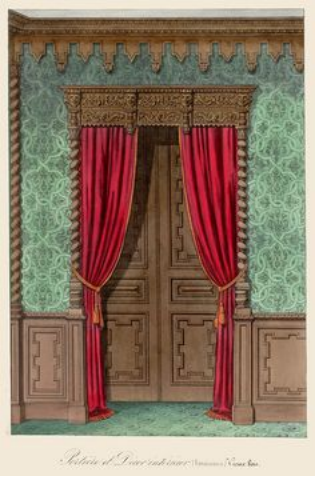
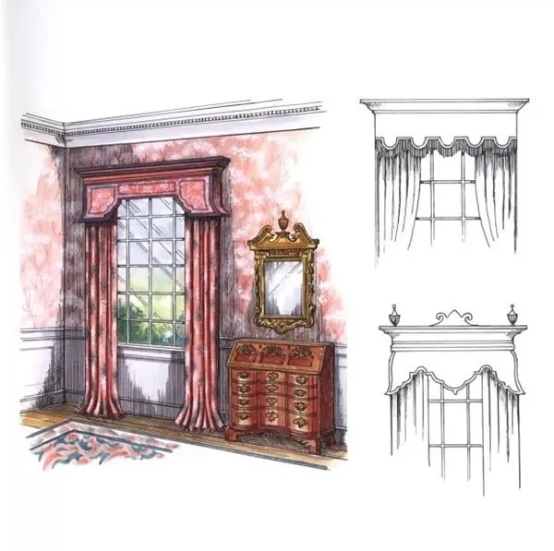
乔治王朝晚期(1714-1770)
所有的乔治王朝晚期的窗饰理念中最重要的莫过于将窗帘和床幔匹配起来。在那以前,二者被认为是室内设计中无关的两个方面。富丽的金色、蓝色和红色花缎和织锦在当时即用于窗帘,也用于床罩。这个时期在室内设计中占主要地位的颜色还包括绿宝石色、蓝绿色和珊瑚色。
床幔的使用此时已遍及欧洲,不仅是富丽堂皇的屋舍变得更加温馨,而且还起到装饰作用,由于此时的中产阶级已经买得起大块的英式花园图案的擦光印花棉布,因此促进了这类窗饰和床饰的普及。富人家里通常拥有两套窗幔,一套是在冬季使用的比较厚重的提花织物,另一套是使用质地较轻的平纹细布织物。
外观优雅、装饰精美的窗帘主宰了乔治王朝晚期。贴花和刺绣技术促使外观设计进一步丰富。在窗帘箱下方绳子拉起来的波浪状花彩百叶帘,当时被视为欧洲外观最时尚的窗饰。
乔治王朝晚期的窗饰可以被描述为更加飘逸。最新的面料和设计带有柔软的垂饰,是之前的窗饰中从未有过的。在带图案的织物上用绸缎花和华彩作为装饰,更添加了这中飘逸感。
意大利串线式或叠卷式窗帘在当时的英国更为欢迎。这种窗帘是通过窗户外侧上角斜向拉动一根绳子产生花彩的外观,这样便可使窗帘优雅地层叠与拽动。现在的室内设计师仍采用这种非常优雅的方法制造花彩。
巴洛克时期油浸的窗扇作为控制光照量的装置在这个时期仍然通用。经常带有手绘的复杂精细的设计或户外场景的窗扇,是这个时期末卷帘的前身。卷帘是有天然亚麻或棉布制成的,并且使用滑轮系统来卷起来或拉下,以遮阳光和保护隐私。
设计窗帘的比例是根据16世纪的意大利设计师安德烈亚·帕拉迪奥的理念而建立的(及帕拉迪奥原则)。当建筑师们开始来按此比例来设计窗户的样式和外形时,窗帘就变的更为复杂。这些原则指的是根据古希腊古典建筑研究出来的一套特定比例,可应用于各种外观因素,包括窗户。
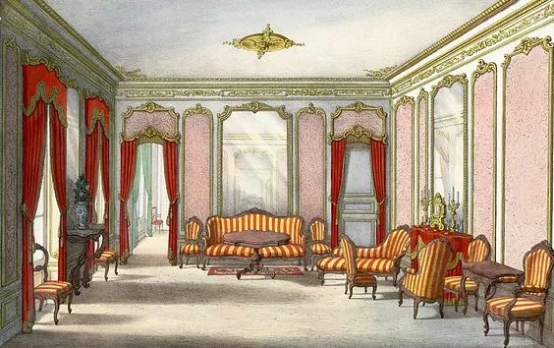
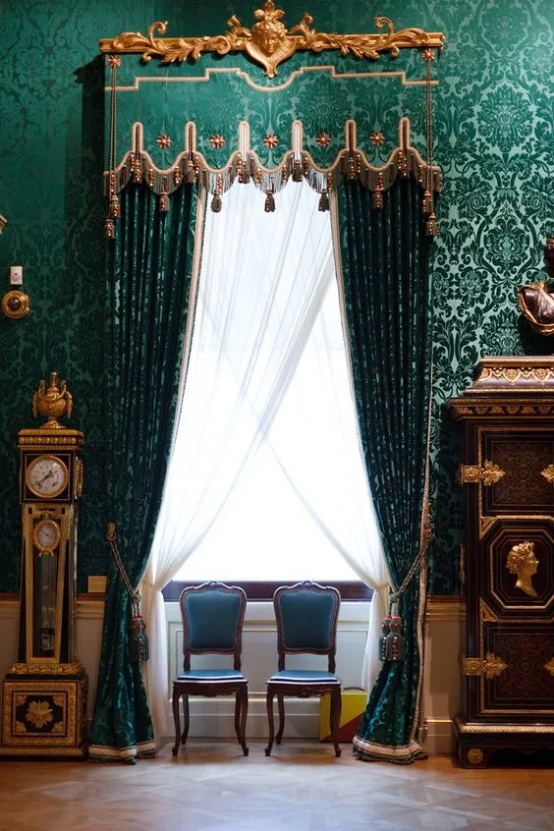
洛可可和路易十五时期(1730-1760)
从巴洛克到维多利亚时代的室内装潢商全权负责房屋的室内设计。精致的床幔和窗饰都是出自这些技艺精湛并且具有影响力的大师之手,他们尽忠职守地监管着实现他们豪华设计所需的各种工艺。这些大师中包括托马斯·器彭代尔的人。
1754年,奇彭代尔出版了一本极具影响力的关于设计的书,及【绅士与家具师指南】。奇彭代尔通常采用中国式的图案和洛可可时期标志性的贝壳图案。这些图案被用于织物上,也用于雕饰富丽的木结构床和其他家具上。
这个时代的窗口形状给设计造成了很多困难,他们在今天也亦然如此。顶部为哥特式风格和具有帕拉第奥式拱顶的窗口风靡整个欧洲和英国。奇彭代尔创造出曲线型的窗帘箱板,然后挂上微折的打褶的三角帘。
这一时期很多窗幔与床幔更为轻柔,更偏好追求舒适,轻质的真丝塔夫稠(即平纹皱丝品)是制作窗帘的一种最常用的布料,颜色清新淡雅,正符合了这个时期的主旋律。这个时期的用色更加雅致;柔和的浅黄、浅粉和浅蓝色取代了上一世纪深暗的宝石色。
拉帘和罗马帘是这个时期最流行的窗帘,这种式样的拉帘要多出宽松位,使它们的外观更为柔和。这些窗帘通常在顶部配有面料较奢华、颜色较深的短幔或配有一个装饰窗帘箱。
纺织业在这个时期的发展为织出经久耐用的面料提供了条件。toiles de iouy是一种产自法国的“朱伊的产品”,它是今天被简称为印花布的面料的起源。印花布是一种使用铜板印花法印出来的面料。这种方法印出的面料更适合设计以及批量生产。用于生产擦光印花棉布的面料也是这个时期引入。
随着顶篷的外观更为轻巧,床的木结构被重新定义,产生了一些变化。半华盖一种较短的顶篷,从墙上伸出盖过床的一部分而不是整张床的长度。lit a la polonaise 是由四个床角上的床柱支撑的半球形顶篷,以美丽的丝绸面料为特色。在法国,将床置于壁龛中,在周围饰以高雅的垂帷成为一种司空见惯的做法。
棉布和丝绸取代巴洛克时期的天鹅绒和提花布这一类厚重的面料被用于顶篷和床幔。洛可可时期标志着从巴洛克时期极尽华丽、精致的风格向主导着18世纪晚期新古典主义的雅致古典风格的过渡。
新古典主义时期(1770-1820)
新古典主义是一种优雅的设计风格,以简单的几何形式为其特点。18世纪在对庞贝和赫基雷尼亚的发掘中找到的古希腊和古罗马的古典艺术品是激发这种风格的源泉。
这些遗迹的发现也激发了新古典主义时期的流行色,包括土褐色,赤土色和绿色在内的一整套大地色都能凸显出黑色。其他影响装饰色彩的因素来自于工业而非历史,韦奇伍德陶瓷激发了当时流行的一系列蓝色,法国的奥布松和哥白林两家挂毯厂使用的颜色也带动了这种色彩流行趋势。
当时,床和顶棚的设计成为了家具师而非室内装潢商的责任。这导致了对床幔的较少关注,也影响了对窗和床都协商的檐板的采用。家具师中有一个托马斯·谢拉顿,他的设计在18Very influential at the end of the century.
Sheraton is famous for its unique bed body and exquisite cornice. With a distinctly Chinese influence, Sheraton introduced pagoda-style cornices. His designs are carved and decorated with classical motifs, published in1973"The Drawing Book of Furniture Makers and Decorators" published in 2010.
Window curtains, the most common tracery of the Neoclassical era, were paired for symmetry, a simpler look that required the modification of curtain rods for decorative or functional purposes. This period introduced history's first cord and pulley rods (now known as sliding curtain rods) to reduce wear and tear on window coverings.
These new pulley bars have an overlap in the middle which greatly enhances the finished look of the bed curtain design. In addition, decorative rods with delicate tips and rings add interest and balance to the simplicity of tracery silhouettes of the period.
At any time, sheer thin fabrics are popular, and multiple layers of curtains are added under the upper curtain. These sheer curtains are attached to the window frames to provide further privacy and sun protection to the room.
The greatest scientific and technological achievement in the production of decorative textiles during this period was Joseph·Kraft Yu1804Jacquard loom invented in 1990. This complex loom allows the most intricate patterns to be machine-woven into fabrics. This used to be done only through painstaking manual labor. Towards the end of the Neoclassical period, the most striking symmetries in the drapery styles were replaced by the asymmetrical appearances that later became popular in the Empire period.